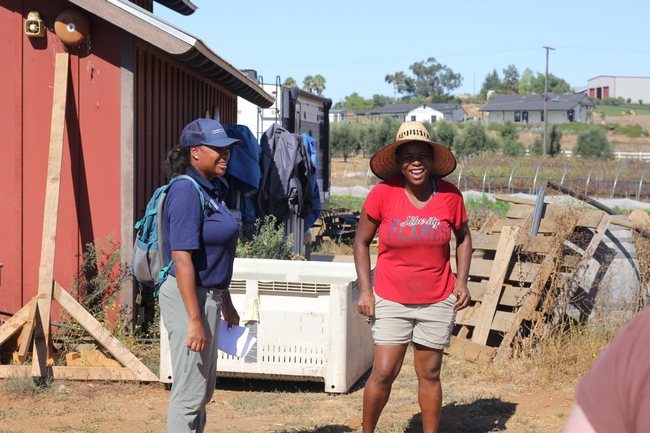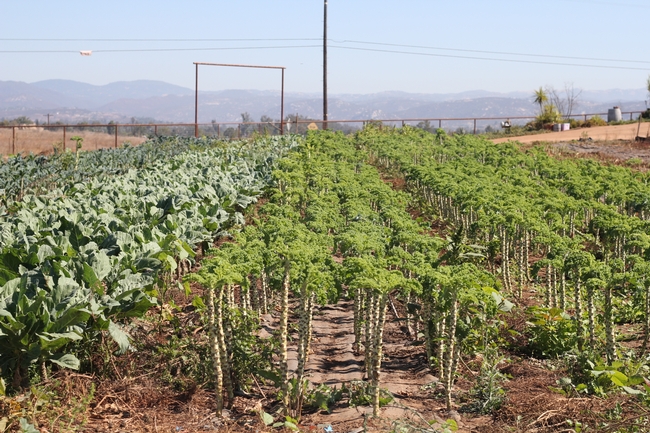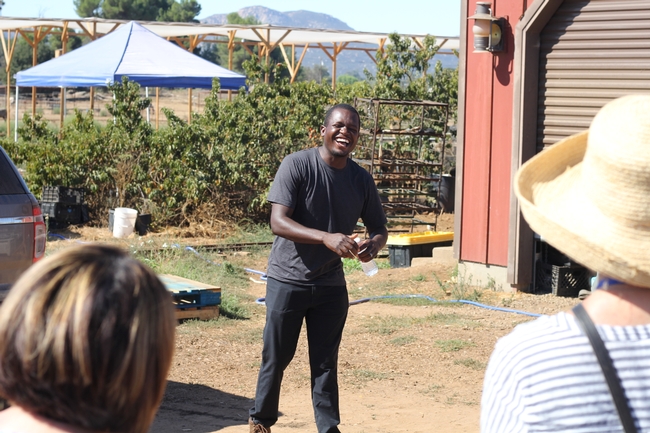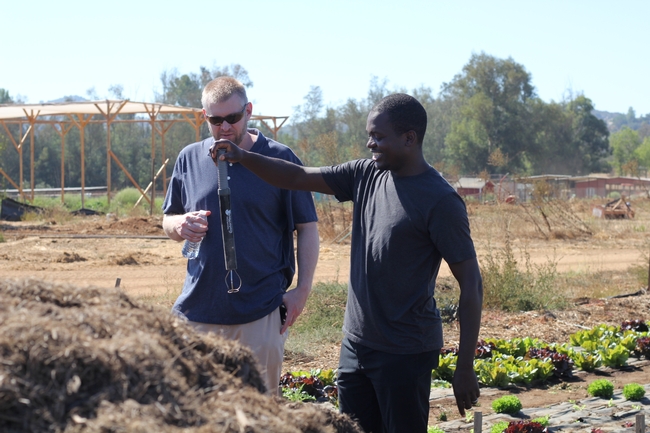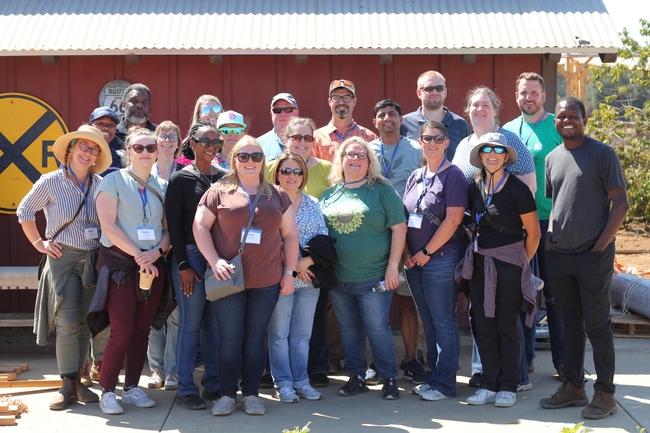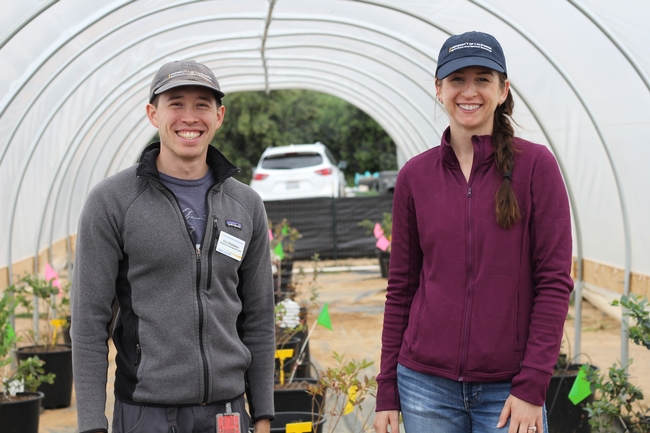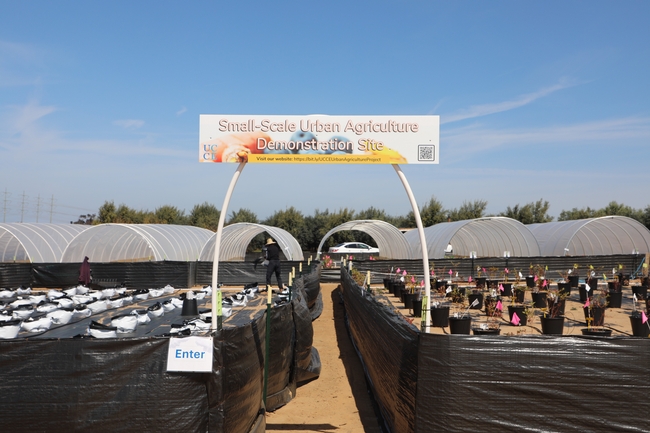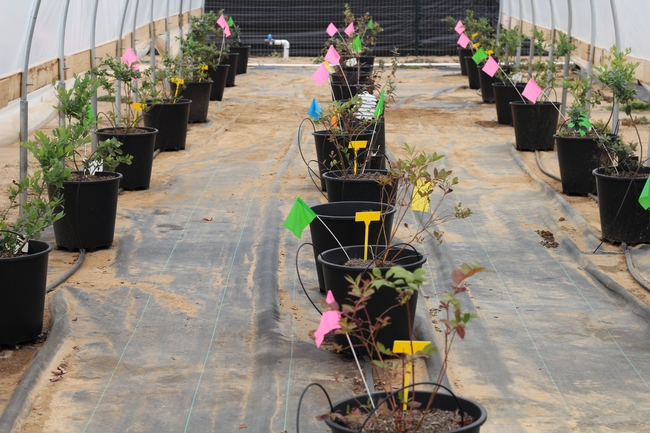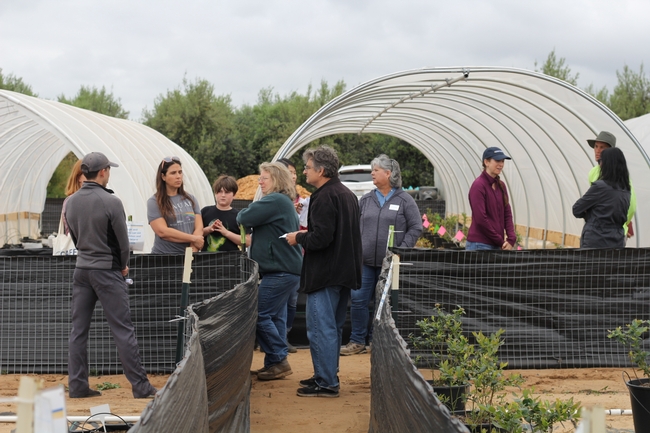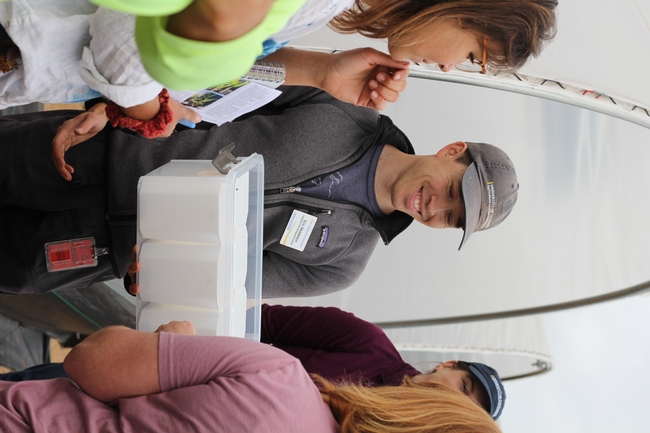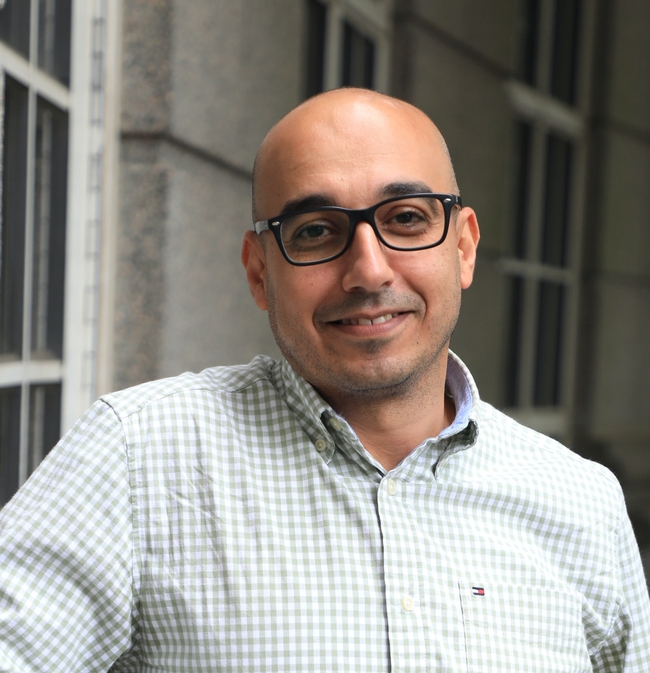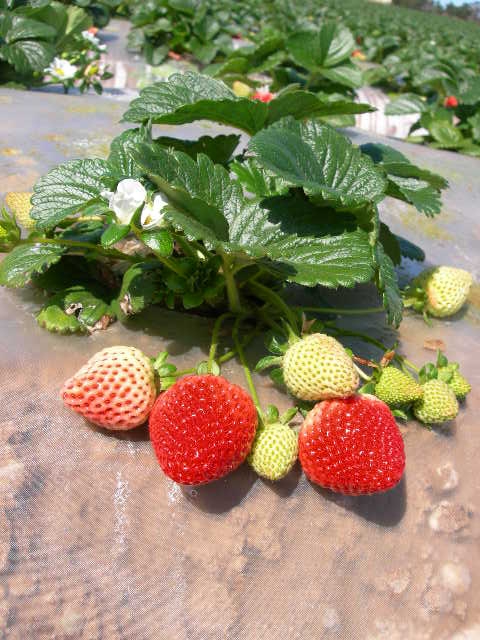Posts Tagged: economic development
UC ANR project to help underserved farmers in SoCal with land ownership
San Diego County has more than 5,000 small farms but less than 2% are operated or owned by Black, indigenous, or people of color – including those of Asian, Hispanic or Native Hawaiian/Pacific Islander descent, according to the 2022 Ag Census.
The reasons vary, but historically, multiple marginalized communities of color have not received the same opportunities or support for land ownership or management as their white counterparts.
Chandra Richards, University of California Cooperative Extension land equity academic coordinator for the Southern California region, is identifying barriers to equity when it comes to addressing land access, tenure, management and opportunities to increase the diversity of land managers and land ownership in the region.
Richards is the principal investigator for the Climate Action and Land Equity (CALE) project administered through UC Agriculture and Natural Resources and funded by the Department of Conservation. CALE aims to engage historically underrepresented communities in coalition building, capacity assessment and climate action planning. CALE elevates knowledge about the challenges and opportunities to land access and management for a diversity of land managers.
Among the challenges is land tenure, an established agreement between a landowner and tenant, outlining the purpose and use of the land over a period of time. However, when landowners decide to sell their land, these agreements are at risk of being null and void, forcing the tenants to renegotiate or discontinue their operation.
Land tenure leases for under five years are considered short-term, which are common in Southern California. For small, new and under-resourced farmers, landowner turnover doesn't just threaten their business plan but their livelihood.
For small farmer Byron Nkhoma, who leases land in Ramona to grow leafy greens and vegetables, the possibility of losing land is a constant worry. Since 2015, Nkhoma and his wife, Joyce, have been renting four of 20 acres to establish Hukama Produce. Over nine years, they have had two landowners. Before the land was sold to his current landowner, Nkhoma said he considered buying land, but the process proved more challenging than he thought.
“What it takes for someone like Byron to find a place to farm and establish a food system is an extremely involved process,” said Richards. “It's not just learning how to obtain land, it's also about managing that land so it can be used for years and generations to come.”
Originally from Zimbabwe, Nkhoma is adamant about taking care of the land he leases and has applied knowledge from his home to ensure resilience. Hukama Produce prides itself in improving environmental health through sustainable farming practices such as compost and mulch application, drip irrigation and low till. An important pillar of the CALE project includes building capacity and providing technical assistance toward land conservation and climate resiliency.
In addition to land tenure, money and time are stressors for small farmers. When they are not working on the farm, Nkhoma and his wife are researching and applying for grants to improve their soils and protect their crops from pests. However, many grants for which Hukama Produce is eligible often have pressing deadlines that demand their immediate attention – cutting into valuable time that could be spent tending to the land or selling at farmer's markets.
Two of Hukama's goals include building and sustaining trust in the market and growing their operation. By partnering with Richards, Hukama Produce has direct access to technical assistance focused on grant writing and conservation to increase ecosystem health and build tenure.
Agricultural land tenure is the arrangement, rights, and responsibilities centered around use, management, and ownership of agricultural land and resources. Building land tenure means that farmers have a stable place to grow their crops and build environmental sustainability without risk of having to move their operations.
While the CALE project boosts support for historically underserved community members hoping to own or manage land, it prioritizes land use for food production as a reinvestment into the greater community.
Eager to bring realities like Nhkoma's to light, Richards partnered with Keith Nathaniel, UCCE director for Los Angeles County, who co-coordinated the Western Extension Leadership Development conference held in San Diego the week of Sept. 23-27. WELD unites Cooperative Extension faculty, agents, advisors, educators and specialists from the western region of the United States for a two-year leadership development program.
While in San Diego, WELD participants joined Richards for a tour of Hukama Produce and learned directly from Nkhoma about opportunities and threats as a small farmer. The tour ended with participants in a circle, sharing how their professional roles can offer support to Hukama Produce and other small farms.
“We grow food so that we can feed the community,” said Nkhoma. “When we feed others, we build relationships. That's what ‘hukama' means – to grow relationships.”
If you operate or know of a small farm in Southern California and would like to be involved with or receive regular updates about the CALE project, please contact Chandra Richards at cmrichards@ucanr.edu.
If you are interested in applying for the Land Equity Project Manager position, please visit https://ucanr.edu/About/Jobs/?jobnum=2894 for details.
Could empty lots be growing food, economic opportunity?
UCCE scientists study feasibility of specialty crops for small urban growers
The vacant lots around your neighborhood could be growing fruits and vegetables and making local produce more accessible – while reducing energy needed to transport and distribute the food. Could turning those empty lots into small farms also become opportunities for economic development?
To answer this question, a team of researchers from University of California Cooperative Extension in San Diego County are investigating the economic feasibility of growing high-value specialty crops in urban settings like vacant lots. The project – led by Eric Middleton, UCCE integrated pest management advisor for San Diego, Orange and Los Angeles counties – is currently in progress at The Flower Fields in Carlsbad, a seasonal attraction for locals and tourists.
Tucked away in the back of the field is the Small-Scale Urban Ag Demonstration Site where Middleton and his team established a small farm on approximately 17,000 square feet, starting fall 2023. Funded by the U.S. Department of Agriculture National Institute of Food and Agriculture, the farm is designed to evaluate containerized production both outdoors and under high tunnels.
Growers don't necessarily need land, just space
High tunnels, also referred to as hoop houses, are semi-permanent structures that act similarly to greenhouses in providing a controlled environment. For the experiment, Middleton will compare cost, effort and durability of two types of high tunnels: one made of steel and the other out of PVC pipes.
“We want to give interested growers information on as many options as we can,” said Middleton, who explained that the project is motivated by the challenges of urban settings, including limited space and lack of arable land.
In the trial, they are growing turmeric, ginger and blueberries. The high-value crops were selected because of their potential to earn a profit. Data evaluating plant variety, soil mix, fertilizer, growth performance, yield and pest and disease pressures will be collected and reported when the project concludes in 2026.
As the crops develop in containers – blueberries in pots and turmeric and ginger in grow bags – Middleton pointed out the mobility aspect of the study, noting that growers don't necessarily need land, just space.
Whether it's a backyard or a rooftop, containerized production means easier transport, especially since vacant land doesn't always remain vacant forever and urban lots may often need soil remediation. Growing in containers solves the anticipated problem of having to relocate.
Where to set up shop in San Diego County
Jan Gonzales, project coordinator and community education supervisor for UCCE San Diego County, is leading the effort to identify available urban land in San Diego County as well as the policies and procedures for growers to access these spaces.
Gonzales is collaborating with community members who are working on similar projects to identify space for prospective growers.
“This has been done before for different objectives and for specific areas in the region, but the information was either project-specific and not publicly available, or not easy to find,” Gonzales said.
Having spoken with people associated with previous or ongoing agricultural land mapping projects, Gonzales has agreed to coordinate and facilitate an advisory work group to discuss areas of potential collaboration and develop project efficiencies. She anticipates holding the first group meeting before the end of the summer.
A production guide to help community members re-create the project
The ideal audience for a study like this is anyone who wants to grow specialty crops, according to Lindsey Pedroncelli, interim director of UC South Coast Research and Extension Center in Irvine, who worked on the project alongside Middleton when she was a staff research associate with UCCE San Diego.
“If you're a new grower or a grower who wants to diversify your crop production, what we're learning here can be applied to you,” said Pedroncelli.
Pedroncelli has been instrumental in bringing the experiment to life and documenting its step-by-step workflow thus far. The production guide, which is being created as the study unfolds, will include instructions detailing how to replicate the experiment from the ground up. Currently, it contains information on how to design your farm, the materials to buy, building structures, irrigation setup and crop management.
The most intriguing open question, whether the operation is profitable, is the driving force behind the production guide and will certainly be addressed, Pedroncelli said.
Book a tour and visit the farm
When visiting the farm, you'll encounter three varieties of blueberries: Star, Snowchaser and Misty. Snowchaser has been a top producer since it was planted in January, but the variety is known to be an early season producer.
Using only one variety of each, the turmeric and ginger were planted in late March-early April. With some unanticipated cold weather in San Diego County, both crops struggled when transitioning out of dormancy, leading to very slow progress, which the team is still navigating today.
Visually, Middleton and his team have noticed differences between the crops growing under the high tunnels versus those grown outdoors, although the data has not been analyzed to confirm or explain notable differences.
Attempting to demonstrate how to profitably grow high-value crops in urban settings using limited space and resources, Pedroncelli said she hopes this study will also encourage people to grow culturally significant crops for their communities.
To tour the Small-Scale Urban Ag Demonstration Site at The Flower Fields in Carlsbad, email Eric Middleton at egmiddleton@ucanr.edu with "Urban Agriculture Demonstration Site Tour" in the subject line.
To learn more about the project and its progress, visit https://ucanr.edu/sites/socalIPM/Small_Scale_Urban_Agriculture_Project_/.
UC food-safety specialist tests biosensors to ensure safe produce
Ahmed El-Moghazy joined UC Agriculture and Natural Resources as a UC Cooperative Extension food safety specialist in February and is based at UC Riverside. Food safety, according to El-Moghazy, are measures that ensure food is free from harmful contaminants, prevent foodborne illnesses and is safe to eat. El-Moghazy is responsible for assisting California farmers and food processing facilities to enhance food safety practices by training appropriate personnel and addressing food-safety issues on their farms.
As the principal investigator for the 2-SAFE Lab at UC Riverside, El-Moghazy is investigating the accuracy and applicability of point-of-use biosensor technology. The small, lightweight and easy-to-use sensor can be used while out in the field or in a packing house to test contamination of liquids such as irrigation and washing water or solids like food samples.
Testing for foodborne pathogens traditionally takes two to three days and the process can be costly. The biosensor technology that El-Moghazy is using is inexpensive and can provide results within one work shift, which allows businesses that grow fresh produce to confirm the safety of their products before sending them to the market.
The alternative, selling contaminated food to consumers, is not only detrimental to human health, but can ruin the reputation of businesses, making way for unanticipated costs associated with recalling contaminated products and regulatory consequences including fines and sanctions.
El-Moghazy is also developing the next generation of antimicrobial surface coatings and materials that can rapidly control the foodborne pathogens and hinder the transfer of harmful bacteria from contaminated food to non-contaminated food.
El-Moghazy is optimistic that his research can safeguard public health, reduce the burden of foodborne illness and protect the integrity of businesses. Although El-Moghazy serves the entire state, he is dedicating a large part of his needs assessment and efforts in Southern California where high-value specialty crops such as avocados and citrus are grown.
"Did you know that one in every six Americans get sick from eating food contaminated with a foodborne pathogen?" asked El-Moghazy. Understanding the fatality of foodborne illnesses, El-Moghazy believes that increasing awareness through education is an essential aspect of his role. "It's true, but not many people realize this, or that 40% of foodborne illnesses stem from fresh produce."
To protect consumers, the U.S. Food and Drug Administration requires farms with a certain level of annual sales (adjusted for inflation) of fruits and vegetables typically consumed raw to have one employee who has completed an FDA-approved Produce Safety Rule Grower Training.
In addition to certified trainings, El-Moghazy offers technical assistance to ensure growers comply before and after inspections, as well as resources for several topics including produce safety, agriculture water, flooding, soil amendments, worker health, hygiene and training and postharvest handling and sanitation. He can also assist in developing food-safety plans and other general farm food-safety protocols. His technical expertise covers all aspects of food production and supply including irrigation water quality, hygiene of harvesting tools and transportation.
Before joining ANR, El-Moghazy completed two years as a visiting scholar in the UC Davis Biological and Agricultural Engineering department before continuing as a postdoctoral fellow in the UC Davis Food Science and Technology department for 5 years. Much of his work was rooted in the development of biosensors and antimicrobial materials for food safety. While in Davis, he collaborated with local farms and food processing companies on food safety research and extension.
El-Moghazy earned a Ph.D. studying developmental biosensors for food safety applications to detect pesticides residues from a joint program offered by University of Perpignan in France and Alexandria University in Egypt. He also earned a master's degree in developmental biobased fungicides and a bachelor's in agriculture science from Alexandria University. Finally, he completed a fellowship at the Institute of Plant Protection, Szent Istvan University in Hungary, where he studied how to extend shelf-life of fresh produce using biomaterials.
El-Moghazy is based at UC Riverside in the Department of Microbiology and Plant Pathology. He can be reached at aelmogha@ucr.edu or (951) 827-0257.
A U.S.-China trade war would cost California farmers
Loss of China's preferred trade status could hurt crop, dairy and livestock exports
The Biden administration recently announced large, increased tariff rates for Chinese electric vehicles, solar cells, semiconductors, and aluminum and steel products. This raises the possibility of another trade war with China that could impact agriculture.
Economists from UC Davis and North Dakota State University evaluated the potential implications of the U.S. revoking China's Permanent Normal Trade Relations (PNTR) status. They found that if China retaliated against a change in China's PNTR status, it could lead to a 9.5% increase in China's agricultural import tariffs, resulting in potential trade losses to California agriculture of around $1 billion annually.
California agriculture was hit hard by the 2018-19 trade war with China, and many industries have still not recovered from its effects. Despite this, there is increasing support in Congress for further restrictions on trade with China, with proponents asserting that China is not complying with the World Trade Organization's regulations.
The authors' research suggests that some product groups – such as horticultural products, dairy, livestock and meats – would likely experience even steeper than average increases in import tariffs.
“The impact on import tariffs for non-agricultural sectors would be even larger, with the average import tariff going up from 3.9% to 32.5%,” said co-author of the study Colin A. Carter, Distinguished Professor in the Department of Agricultural and Resource Economics at UC Davis.
For all California agricultural exports, they estimated an average decline in export value between 28.4% and 34.8% when comparing a scenario where China's PNTR status is revoked to one where it is not. This translates into an estimated trade loss of between $800 million and $1 billion, using 2023 California agricultural exports. Some crops that rely heavily on China for exports, such as tree nuts, would be more severely impacted by these effects, particularly considering that some of them are still subjected to residual tariffs from the 2018-19 trade war.
The last trade war between the United States and China led to significant decreases in crop prices and lost export opportunities. As co-author Sandro Steinbach, Associate Professor in the Department of Agribusiness and Applied Economics and the Director of the Center for Agricultural Policy and Trade Studies at North Dakota State University notes, “Once access to a market is lost, gaining it back is difficult, as the 2018-19 trade war has shown.”
To learn more about the potential implications of the United States revoking China's preferred trade status, read the full article by Carter and Steinbach: “Revoking China's Preferred Trade Status Would Be Costly for California Agriculture,” ARE Update 27(4): 1–4. UC Giannini Foundation of Agricultural Economics, online at https://giannini.ucop.edu/filer/file/1715033514/20982/.
ARE Update is a bimonthly magazine published by the Giannini Foundation of Agricultural Economics to educate policymakers and agribusiness professionals about new research or analysis of important topics in agricultural and resource economics. Articles are written by Giannini Foundation members, including University of California faculty and Cooperative Extension specialists in agricultural and resource economics, and university graduate students. Learn more about the Giannini Foundation and its publications at https://giannini.ucop.edu/.
New UC study estimates costs for growing strawberries on the Central Coast
A new study that can help growers and other readers estimate costs and potential returns for growing strawberries on California's Central Coast was recently released by UC Agriculture and Natural Resources, UC Cooperative Extension and the UC Davis Department of Agricultural and Resource Economics.
“This study provides growers with a baseline to estimate their own costs, which can help when applying for production loans, projecting labor costs, securing market arrangements, or understanding costs associated with water and nutrient management and regulatory programs,” said Brittney Goodrich, UC Cooperative Extension specialist and study co-author.
The cost study models a management scenario for a 50-acre farm, 45 acres of which are planted to strawberries, located in Santa Cruz, Monterey or San Benito counties. The remaining acres are for the irrigation system, roads and buildings. The study describes the cultural practices used in strawberry production and harvest, including land preparation, soil fertility and pest management, irrigation and labor needs.
The 19-page study shows costs for each operation, material inputs and costs, and cash and non-cash overhead costs in a variety of formats for one production and harvest cycle. A ranging analysis is also included and shows potential profits or losses over a range of prices and yields.
The new study, titled “2024 Sample Costs to Produce and Harvest Strawberries” can be downloaded from the UC Davis Department of Agricultural and Resource Economics website at https://coststudies.ucdavis.edu.
For a detailed explanation of the assumptions and calculations used to estimate the costs and potential returns for each crop, readers can refer to the narrative portion of each study.
For more information, contact Mark Bolda, University of California Cooperative Extension farm advisor, at mpbolda@ucanr.edu, or Jeremy Murdock in the Department of Agricultural and Resource Economics at jmmurdock@ucdavis.edu.
Sample cost of production studies for many other commodities grown in California are also available at https://coststudies.ucdavis.edu.


